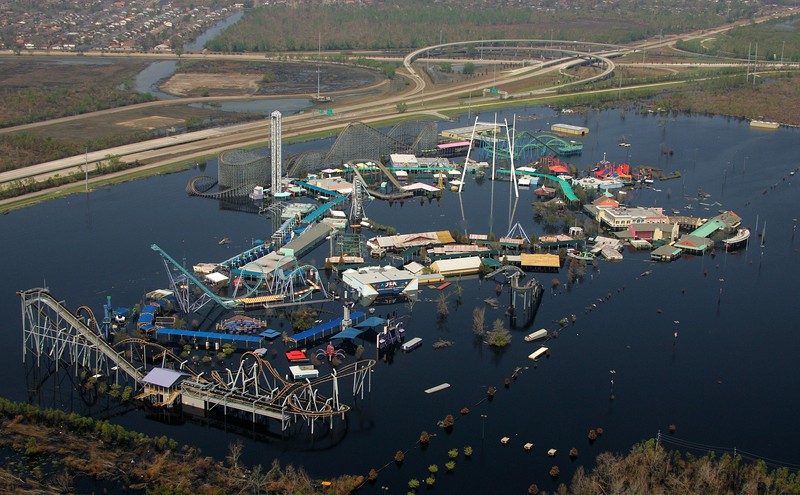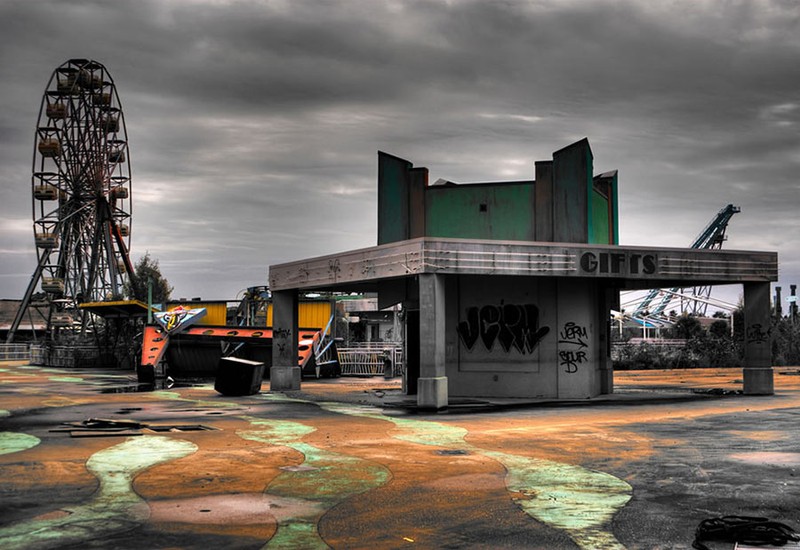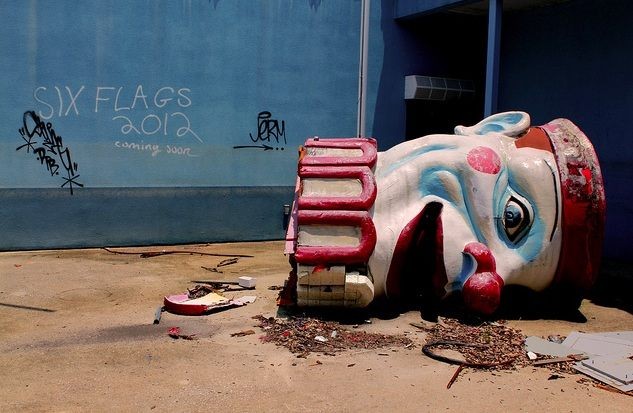Six Flags New Orleans "Jazzland" (2000-2005)
Introduction
Text-to-speech Audio
Jazzland started life as a symbol of New Orleans' vibrant culture, and the amusement park initially featured areas dedicated to Mardi Gras, Cajun Country, the French Quarter, and its predecessor Ponchartrain Beach, an amusement park that had closed in 1983. Six Flags purchased the park in 2002, renaming the park and also investing significant resources to improvements. In 2005, the park suffered immense damage after Hurricane Katrina, leaving the rides under salty water for more than a month. Unable to recoup their losses, Six Flags sold the park to the city, and it has sat abandoned ever since, an impressive testament to this day of the damage caused to the spirit of New Orleans itself by the massive storm. That said, the deteriorating rides are dangerous, and entry is considered trespassing. As such, the park ruins are best observed from the outside, at a safe distance.
Images
Aerial view of abandoned Six Flags New Orleans

Abandoned Six Flags New Orleans

The infamous downed remains of a clown sculpture

Backstory and Context
Text-to-speech Audio
Six Flags New Orleans was initially called Jazzland. The park opened 17 years after the 1983 closure of the Ponchartrain Beach theme park, which ran since 1928, and in that period, the closest amusement park to New Orleans was Astroworld, around 350 miles away in Houston. The idea behind Jazzland was not only to give New Orleans its own long-overdue theme park once again but to give it a unique park that would center around the area's rich history. With that in mind, Tom and Dian Winingder opened the park on a 220-acre plot of swamp that had been in Dian's family for 50 years. To be loyal to the city's rich history, the couple envisioned unique areas within their developing park dedicated to Mardi Gras, the French Quarter, Cajun Country, and its predecessor, Ponchatrain Beach. It took ten years to complete the project due to investors backing out and new ones joining, but the park finally opened in May 2000.
Jazzland's initial opening was met with great fanfare and excellent attendance in the first season. In the following year, though, the park began to struggle. The opening season saw more than a million visitors, but that number dropped by half the following year. The lack of a waterpark was a deterrent to visitors since few people wanted to stand in long lines in the blazing New Orleans sun. Investor Alfa Smartparks began to struggle under an $80 million pile of debt, having been more used to running smaller waterparks before Jazzland opened. The park went bankrupt in 2002 and was quickly bought out by Six Flags, who attached a 75-year lease to their purchase. The corporation added numerous improvements to the park in the following years, such as canopies and shaded areas to relieve overheating visitors and up-to-date rides featuring characters from Looney Tunes and DC Comics.
By 2005, Six Flags itself was struggling, and there were rumors that their New Orleans park would close or be sold in the coming years. Sadly, Former Jazzland did not last long enough to get to that point. In late August 2005, Six Flags New Orleans moved operations from daily summer hours to weekends only for the fall season, as they had done every year. Just a few days after this, Tropical Storm Katrina strengthened into a hurricane upon landfall in Florida and quickly made its way toward New Orleans. The city as a whole proved unprepared to handle the catastrophic Category 5 storm as it swept through the city. The levees that were meant to protect New Orleans from floods failed, and twenty percent of the city flooded, causing billions of dollars of damage.
Six Flags New Orleans was under seven feet of brackish water for over a month. As the water receded, it was clear that the rides had taken significant structural damage, and mold quickly flourished in the humid climate. The company tried to recoup its losses but quickly learned their insurance policies explicitly excluded flood damage, leaving them with no way to repair the park. The only salvageable ride was the Batman roller coaster. The park was declared a total loss, and Six Flags terminated its lease and sold the park for half its initial cost to the city, declaring bankruptcy for a multitude of reasons in 2009. Over the years, New Orleanian businesspeople have proposed different options for the deteriorating park, including a revival of Jazzland, a power plant, and a shopping mall. However, all plans fell through, and the park ruins still stand today.
Sources
Christopher, Matthew. Six Flags New Orleans, Abandoned America. February 8th, 2023. Accessed March 18th, 2023. https://www.abandonedamerica.us/six-flags-new-orleans.
Thomas, Greg. From Wasteland to Jazzland, The Unofficial Jazzland Web Page. Accessed March 18th, 2023. https://jazzlandfan.tripod.com/from.htm.
Abandoned Jazzland, Atlas Obscura. Accessed March 18th, 2023. https://www.atlasobscura.com/places/six-flags-abandoned-amusement-park.
Nola Ghosts
Antique Archaeology
Atlas Obscura
